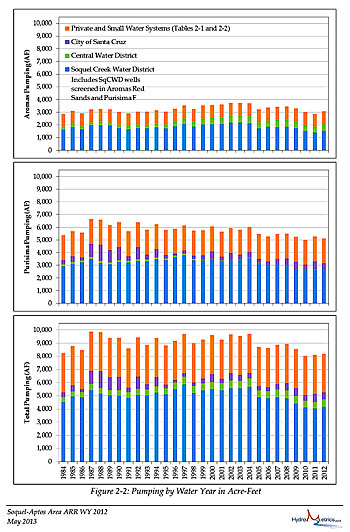By Kim Adamson, General Manager for Soquel Creek Water District
Coming from a state with a well-developed groundwater rights process, I was surprised to find no such system here. Currently, California’s largest water source, groundwater, is unregulated and landowners typically can pump as much as they want with little or no oversight. This has resulted in decades of intense pumping statewide and extremely low water tables. In coastal areas, we are seeing seawater intrusion and while the ground is actually sinking in the Central Valley. Aquifers are at risk of running dry because they are being overdrafted.

The groundwater basin in the mid-county area is a shared resource. Soquel Creek Water District (SqCWD) draws water out of it along with other municipal water agencies like the City of Santa Cruz, Central Water District, and many small and large private pumpers. SqCWD accounts for about half the water pumped from the basin; the other half is used by the other pumpers who share this resource.
The two bills under consideration in Sacramento are intended to establish regulations for groundwater management. AB1739 and SB1168 would set up a framework for sustainable local management of groundwater basins. It would require that we create a groundwater sustainability plan that would be used to reverse and prevent overdraft in the basin by monitoring how much water is being removed and taking steps to reduce use when necessary. Among other management tools, the bills require that large users, public and private, monitor and report their water use each year in order to facilitate management.
Q: What happens if local agencies don’t establish and form a sustainability agency?
A: If local governments didn’t set up oversight systems or failed to show progress, state officials would step in to write and then enforce the local rules. We could lose local control of a local resource.
Q: What would a groundwater sustainability plan include?
A: The plan could include any one of these topics:
- Well construction policies
- Basin replenishment projects
- Measures addressing conservation, groundwater recharge, storage, conservation, water recycling, conveyance, & extraction
- Control and evaluation of seawater intrusion
Q: What kind of powers and authority would a groundwater sustainability agency have?
- Require large users to register and meter their facilities
- Collect fees to support basin sustainability efforts
- Monitor groundwater use and enforce compliance with requirements of the plan
- Import or export and store ground or surface water for future use
- Treat polluted water by recycling, purifying, desalination, etc.
One important thing to note is that through a cooperative agreement with other agencies, these powers already exist. The District, along with Central Water District and a private well owner representative have been overseeing a management plan for years. As part of that effort, over 80 monitoring wells in 25 different locations have been tracking water quality and groundwater levels in the two aquifers that make up our water supply.
We are currently working and developing regional partnerships to include the city, county and Pajaro Valley Water Management Agency in the cooperative management efforts. This group will be overseeing additional scientific data collection and analysis such as a groundwater model and determining where the seawater that threatens our supply is located at the coast. We have also initiated open discussions with all well users in the basin and have been hosting a series of Groundwater Stakeholder meetings since May. You can find the dates and locations of those meetings on our website.
The big change that could be brought by the state legislation is the loss of local power if we can’t demonstrate how we will sustainably manage our groundwater resources by the year 2040. We will no longer be making the decisions that affect us, they will be made in Sacramento.
I encourage you to become engaged in the groundwater dialogue that is happening in our local area and throughout the state. To see the proposed bills:
- AB1739 (Dickenson): www.leginfo.ca.gov/pub/13-14/bill/asm/ab_1701-1750/ab_1739_bill_20140804_amended_sen_v96.pdf
- SB1168 (Pavley): www.leginfo.ca.gov/pub/13-14/bill/sen/sb_1151-1200/sb_1168_bill_20140804_amended_asm_v95.pdf
Our September 9th Groundwater Stakeholder Meeting will be held from 7-9PM at Soquel Congregational Church and include a presentation by Russ McGlothlin, water rights attorney for Brownstein Hyatt Faber Schreck who will address how this proposed legislation can be implemented at a local level.
To access more information on our groundwater stakeholder group meetings: http://www.soquelcreek water.org/our-water-groundwater/stakeholder-advisory-committee